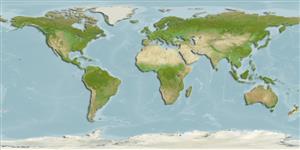Common names from other countries
Teleostei (teleosts) >
Blenniiformes (Blennies) >
Tripterygiidae (Triplefin blennies) > Tripterygiinae
Etymology: Apopterygion: Greek, apo = outside + Greek, pterygion = diminutive of pteryx = fin (Ref. 45335); oculus: Oculus (Latin) means "eye", and refers to the ocellate black bloch on the second dorsal fin..
More on authors: Fricke & Roberts.
Environment: milieu / climate zone / depth range / distribution range
Ecology
Marine; demersal; non-migratory; depth range 14 - 186 m (Ref. 13227). Temperate
Southwest Pacific: endemic to New Zealand.
Size / Weight / Age
Maturity: Lm ? range ? - ? cm
Max length : 6.3 cm SL male/unsexed; (Ref. 13227)
Short description
Identification keys | Morphology | Morphometrics
Dorsal spines (total): 16 - 19; Dorsal soft rays (total): 9 - 13; Anal spines: 2; Anal soft rays: 20 - 26. 19-25 pored scales in the anterior lateral line series, 16-20 notched scales in the posterior series, the second dorsal fin with an ocellate black blotch distally on 4th-6th membranes, the anal fin with about 11 dark streaks, the pelvic fin basally black, rays distally yellowish, with brown spots, and the dorsal fin spines densely covered with small spinules.
Adults are said to be associated with red coralline gravel and shell substrates (Ref. 13227). Eggs are hemispherical and covered with numerous sticky threads that anchor them in the algae on the nesting sites (Ref. 240). Larvae are planktonic which occur primarily in shallow, nearshore waters (Ref. 94114).
Life cycle and mating behavior
Maturities | Reproduction | Spawnings | Egg(s) | Fecundities | Larvae
Fricke, R., 1994. Tripterygiid fishes of Australia, New Zealand and the southwest Pacific Ocean (Teleostei). Theses Zool. 24:1-585. (Ref. 13227)
IUCN Red List Status (Ref. 130435)
CITES (Ref. 128078)
Not Evaluated
Threat to humans
Harmless
Human uses
Fisheries: of no interest
Tools
Special reports
Download XML
Internet sources
Estimates based on models
Preferred temperature (Ref.
115969): 8.8 - 15.6, mean 12 (based on 36 cells).
Phylogenetic diversity index (Ref.
82804): PD
50 = 0.7500 [Uniqueness, from 0.5 = low to 2.0 = high].
Bayesian length-weight: a=0.00794 (0.00346 - 0.01822), b=3.08 (2.88 - 3.28), in cm Total Length, based on LWR estimates for this (Sub)family-body shape (Ref.
93245).
Trophic level (Ref.
69278): 3.2 ±0.4 se; based on size and trophs of closest relatives
Resilience (Ref.
120179): High, minimum population doubling time less than 15 months (Preliminary K or Fecundity.).
Fishing Vulnerability (Ref.
59153): Low vulnerability (10 of 100).
